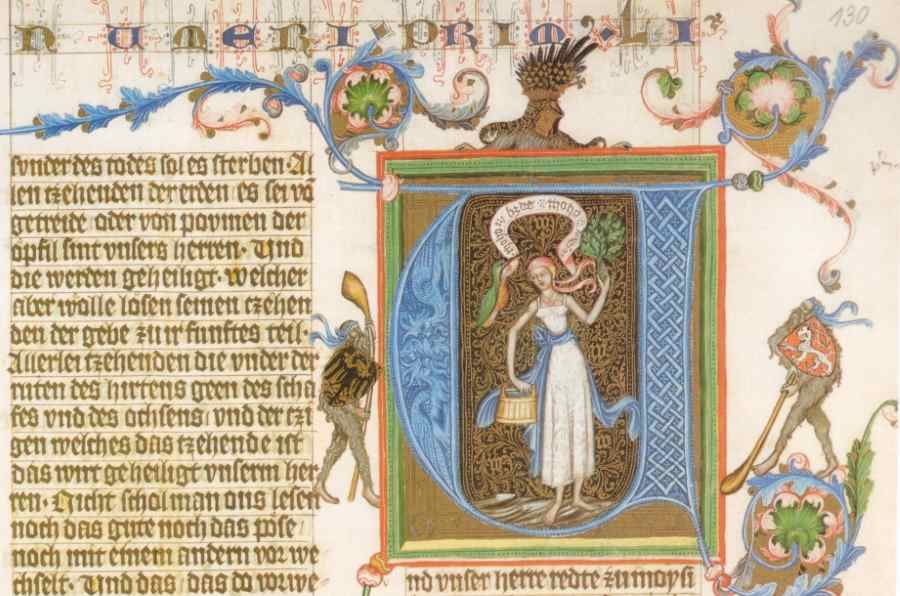Blue pigment reveals unknown role of women in the creation of holy books in the Middle Ages
It was not only monks who wrote down and illustrated medieval manuscripts. Remnants of a rare blue pigment were found in the dental calculus of a woman’s jaw buried about 1,000 years ago. The discovery provides evidence that the scribes were also women.
In the Middle Ages, writing was largely the domain of religious institutions. The richly illustrated manuscripts were produced primarily in monasteries and were intended for use by members of theoin these institutions and the nobility. Someore of these manuscriptow were decorated with precious paints, including gold flakes and ultramarine, a rare and expensive blue pigment extracted from lazurite (lapis lazulite).
International complexo³ scientistow with the Max Planck Institute for the Science of Human History and the University of York has shed some more light on the role of women in the creation of such manuscriptsow. Researchers have identified the aforementioned rare blue pigment in the birthstone of a medieval nun from Dalheim, Germany. The common view mowished to date that scribes were exclusively men. However, according to the researchers, the findings indicate that women were more involved in the creation of sacred books than previously thought.
The findings were published in the journal „Science Advances”.
The discovery was made by accident when scientists began studying the microbiomeoin the mouths of medieval skeletonsow. – The tartar is the only part of the body thatora is subject to fossilization while still alive,” said Christina Warriner of the Max Planck Institute for the Science of Human History, senior author of the publication. – The tartar contains rosorts of debris, such as pieces of food. They get trapped in it and, in effect, become a kind of time capsule – she added.
One of the skeletonsoA skeleton from the monastery cemetery in Dalheim, unearthed some time ago during construction work, contained lapis lazulite pigment. This skeleton belonged to a middle-aged woman buried between 1000 and 1200.
On the monastery itself, there is not much information. The exact date of its founding is unknown, although a community of women may have been established there as early as the 10th century. The earliest known records relating to the monastery date back to 1244. It is believed that about 14 women lived in the. The monastery burned down in the 14th century.
The woman, in whomorej traces of ultramarine were found, she was 45-60 years old at the time of her death. She had no particularolnych bone pathologies, nor a trace ofoin trauma or infection. The only unusual aspect of its remainsow it h blue marks on the teeth.
– It came as a complete surprise. When the tartar dissolved, it released hundreds of tiny blue particles – said Anita Radini of the University of York, cooauthor of the publication. A careful analysis using a series of roof spectrographic methods – including X-ray energy dispersive spectroscopy (SEM-EDS) and Raman microspectroscopy – revealed a blue pigment created from lapis lazuli.
Radini admitted that she and her team have analyzed a number of scenarios about how theob mineral moheads would embed themselves in the woman’s tartar. – Based on the distribution of the pigment in her mouth, we concluded that the most likely scenario is that she painted with the pigment herself and put the end of the brush in her mouth while working – explained another wspohe author of the publication, Monica Tromp of the Max Planck Institute for the Science of Human History.
Lapis lazulite pigment was extremely rare in the Middle Ages and therefore fetched prices porown comparable to gold prices. Azurite, from whichorego produced pigment, was brought to medieval Europe from as far away as Afghanistan. It also testifies to the craftsmanship of the woman. Such a precious resource would not have been entrusted to an average artist. Lapis lazuli pigment, along with gold and silver, was used to illustrate the most luxurious manuscriptsow. – Only scribes and painters of exceptional skill would have been entrusted with using them – confirmed Alison Beach of Ohio State University, historian of the project.
This unprecedented discovery. 11th century Germany was an active center of manuscript productionow, but the contribution of women to their creation was hitherto unknown. In the ogole identification of many works from this period is difficult. As a sign of humility for many medieval scribesow and painters have not signed their works.
– Here we have direct proofod on the existence of a woman whoora not only painted, but did so with a very rare and expensive pigment, and in a very unusual place – stated Warinner. – The story of this woman could remain hidden forever without the use of the latest techniques – she added.

